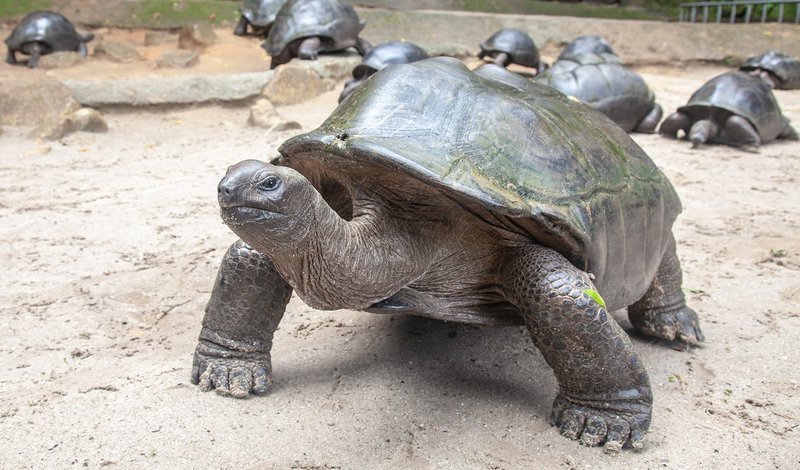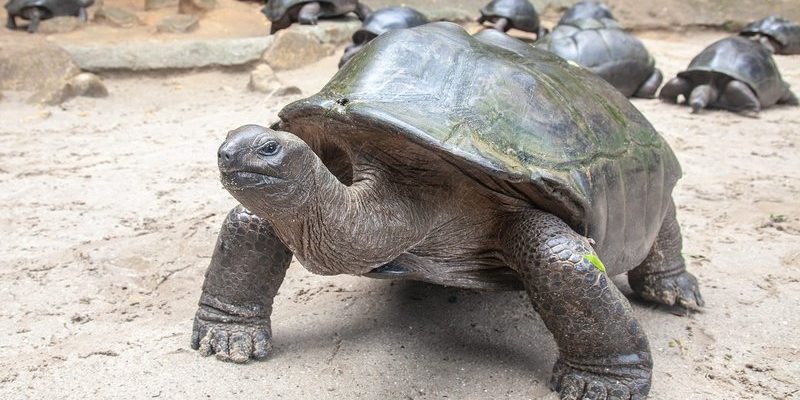
The Aldabra giant tortoise, native to the Aldabra Atoll in the Seychelles, is one of the largest tortoise species in the world. Picture a creature that can weigh over 500 pounds and live for more than a century. They’re often seen munching on grasses and leaves, their slow movements belying a fascinating history. But how did they evolve to become the giants we see today? Let’s dive deep into this ancient journey, exploring their evolutionary background and the factors that shaped their existence.
Origins of the Aldabra Giant Tortoise
The story of the Aldabra giant tortoise begins over 100 million years ago, during the age of the dinosaurs. Back then, tortoises were quite different from what we see today. They roamed across various continents, including Africa, South America, and even Asia. The ancestors of today’s tortoises are believed to have emerged during this time, adapting to their environments in unique ways.
As land masses shifted and climates changed, the ancestors of the Aldabra giant tortoise made their way to isolated islands. Here, isolation played a huge role in their evolution. Living in a restricted environment, they faced fewer predators and competition for food. This allowed them to grow larger over generations—a classic example of “island gigantism,” where species on islands evolve to become bigger than their mainland relatives.
You might wonder how isolation leads to growth instead of extinction. Well, it’s all about survival. In a space with limited threats, larger tortoises could better store energy and water, making them well-suited for the dry conditions of the Aldabra Atoll. Imagine having an advantage that helps you thrive while others around you struggle—that’s exactly what happened!
Physical Characteristics
Aldabra giant tortoises are famous for their massive size and distinctive features. These tortoises can weigh anywhere from 300 to 500 pounds, with some exceeding that weight! Their shells, which can reach up to four feet in length, are dome-shaped and provide excellent protection against the elements.
But what’s really interesting is how their physical traits developed over time. For example, their long necks allow them to munch on higher vegetation, giving them access to food that shorter tortoises can’t reach. Think of it as a built-in advantage—they can feast on delicacies that are out of reach for their smaller cousins.
Another fascinating aspect is their skin. The Aldabra tortoise has thick skin that helps them retain moisture in hot environments. It’s like wearing a natural sunblock! With their ability to go without water for long periods, they’re perfectly adapted to the harsh conditions of their native habitat.
Diet and Habitat
The Aldabra giant tortoise thrives in its natural habitat of the Aldabra Atoll, where lush vegetation meets dry, sandy soils. Their diet consists primarily of grasses, leaves, and fruits. Being herbivores, they play a vital role in their ecosystem by helping to maintain the health of the vegetation.
Imagine being a tortoise, slowly munching on greens while soaking up the sun. They use their beaks, strong enough to shred tough plants, to graze. During the rainy season, they feast on plenty of food. But when it gets dry, they can make do with less, thanks to their ability to store fat and moisture in their bodies.
Here’s the thing: their diet isn’t just about survival; it’s crucial for the health of the island. By eating and dispersing seeds, they help new plants grow, creating a cycle of life that supports their entire ecosystem. It’s a beautiful balance—tortoises and plants thriving together.
Threats and Conservation
Despite their resilience, Aldabra giant tortoises face several threats. One of the most significant is habitat loss, often due to human activity. As people encroach on their natural habitat, these tortoises lose their homes and access to food. It’s like taking away their buffet and expecting them to survive.
Another challenge is climate change. Rising sea levels and changing weather patterns can affect their food supply and breeding grounds. Imagine trying to find a stable home when the Earth is in flux—difficult, right?
Fortunately, there are conservation efforts underway. The Aldabra Atoll has been designated a UNESCO World Heritage Site, and extensive protection measures are in place. Local organizations are working hard to monitor tortoise populations and educate the public about their plight. Strong community involvement is critical; after all, protecting these tortoises means preserving an entire ecosystem.
Reproduction and Lifespan
Reproduction in Aldabra giant tortoises is a slow and steady process, much like their overall lifestyle. Mating typically occurs during the wetter months, and females lay eggs in nests dug into sandy soil. A single clutch can contain anywhere from 10 to 25 eggs! After about 120 days, tiny tortoises emerge, ready to take on the world.
However, not all hatchlings survive. Predation from birds and other animals can be a significant threat at this stage. It’s a tough world out there, even for the future giants! As they grow, they find protection in their shells, which provide safety against many dangers.
Speaking of growing old, Aldabra tortoises can live well over 100 years. Some even reach 200! This incredible lifespan allows them to witness significant changes in their environment. Imagine having a front-row seat to the evolution of your habitat over centuries—that’s something!
The Role in Ecosystems
The Aldabra giant tortoise plays a crucial role in its ecosystem. As herbivores, they help shape the landscape by controlling plant growth and dispersing seeds. This means they not only survive but also contribute to the health of their environment.
By grazing on various plants, they prevent overgrowth and allow sunlight to reach the ground, helping other plants thrive. This balance is essential for maintaining biodiversity on the island. Think of them as nature’s gardeners, shaping the land while they munch away!
These tortoises also serve as hosts for various species, meaning other animals benefit from their presence as well. Birds often build nests on or near tortoises, enjoying the safety and warmth provided by their large shells. It’s all interconnected—when you help one species thrive, you often boost countless others along the way.
The Aldabra Giant Tortoise Today
As of now, the Aldabra giant tortoise population is currently stable, thanks to extensive conservation efforts. You can find them roaming the Aldabra Atoll freely, a testament to the power of focused protection and mindful stewardship.
Zoos and conservation programs worldwide also keep these tortoises to educate people about their importance. They are not just fascinating creatures; they remind us of the need to protect our planet’s diverse ecosystems. Imagine visiting a zoo where you can see these magnificent animals up close and learn about how we can help conserve their habitats!
Honestly, we have a lot to learn from the Aldabra giant tortoise. Their history teaches us about resilience and the importance of adapting to our surroundings. In a world that often seems fast-paced and ever-changing, these gentle giants remind us to take things slow and care for our environment.
In summary, the story of the Aldabra giant tortoise is a beautiful tapestry woven through time, showing how species adapt and thrive despite challenges. Their legacy is not just a natural wonder but a call to action for conservation and sustainability in our ever-evolving world.

